Perineuronal nets and GABAergic cells in the inferior colliculus of guinea pigs
- PMID: 24409124
- PMCID: PMC3884149
- DOI: 10.3389/fnana.2013.00053
Perineuronal nets and GABAergic cells in the inferior colliculus of guinea pigs
Abstract
Perineuronal nets (PNs) are aggregates of extracellular matrix that have been associated with neuronal plasticity, critical periods, fast-spiking cells and protection from oxidative stress. Although PNs have been reported in the auditory system in several species, there is disagreement about the distribution of PNs within the inferior colliculus (IC), an important auditory hub in the midbrain. Furthermore, PNs in many brain areas are preferentially associated with GABAergic cells, but whether such an association exists in the IC has not been addressed. We used Wisteria floribunda agglutinin staining and immunohistochemistry in guinea pigs to examine PNs within the IC. PNs are present in all IC subdivisions and are densest in the central portions of the IC. Throughout the IC, PNs are preferentially associated with GABAergic cells. Not all GABAergic cells are surrounded by PNs, so the presence of PNs can be used to subdivide IC GABAergic cells into "netted" and "non-netted" categories. Finally, PNs in the IC, like those in other brain areas, display molecular heterogeneity that suggests a multitude of functions.
Keywords: GABA; auditory; extracellular matrix; inhibition; midbrain; plasticity.
Figures

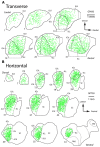


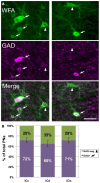

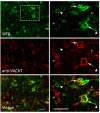

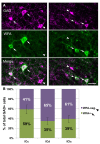
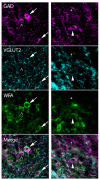
Similar articles
-
The Density of Perineuronal Nets Increases With Age in the Inferior Colliculus in the Fischer Brown Norway Rat.Front Aging Neurosci. 2020 Feb 11;12:27. doi: 10.3389/fnagi.2020.00027. eCollection 2020. Front Aging Neurosci. 2020. PMID: 32116654 Free PMC article.
-
Extracellular Molecular Markers and Soma Size of Inhibitory Neurons: Evidence for Four Subtypes of GABAergic Cells in the Inferior Colliculus.J Neurosci. 2016 Apr 6;36(14):3988-99. doi: 10.1523/JNEUROSCI.0217-16.2016. J Neurosci. 2016. PMID: 27053206 Free PMC article.
-
Inferior collicular cells that project to the auditory thalamus are increasingly surrounded by perineuronal nets with age.Neurobiol Aging. 2021 Sep;105:1-15. doi: 10.1016/j.neurobiolaging.2021.04.001. Epub 2021 Apr 21. Neurobiol Aging. 2021. PMID: 34004491 Free PMC article.
-
Perineuronal nets in the auditory system.Hear Res. 2015 Nov;329:21-32. doi: 10.1016/j.heares.2014.12.012. Epub 2015 Jan 9. Hear Res. 2015. PMID: 25580005 Review.
-
An Extracellular Perspective on CNS Maturation: Perineuronal Nets and the Control of Plasticity.Int J Mol Sci. 2021 Feb 28;22(5):2434. doi: 10.3390/ijms22052434. Int J Mol Sci. 2021. PMID: 33670945 Free PMC article. Review.
Cited by
-
Expression of aggrecan components in perineuronal nets in the mouse cerebral cortex.IBRO Rep. 2018 Feb 8;4:22-37. doi: 10.1016/j.ibror.2018.01.002. eCollection 2018 Jun. IBRO Rep. 2018. PMID: 30135949 Free PMC article.
-
Losing the sugar coating: potential impact of perineuronal net abnormalities on interneurons in schizophrenia.Schizophr Res. 2015 Sep;167(1-3):18-27. doi: 10.1016/j.schres.2014.12.040. Epub 2015 Jan 16. Schizophr Res. 2015. PMID: 25601362 Free PMC article. Review.
-
Perineuronal nets in subcortical auditory nuclei of four rodent species with differing hearing ranges.J Comp Neurol. 2018 Apr 15;526(6):972-989. doi: 10.1002/cne.24383. Epub 2018 Jan 17. J Comp Neurol. 2018. PMID: 29277975 Free PMC article.
-
Age-related upregulation of perineuronal nets on inferior collicular cells that project to the cochlear nucleus.Front Aging Neurosci. 2023 Nov 20;15:1271008. doi: 10.3389/fnagi.2023.1271008. eCollection 2023. Front Aging Neurosci. 2023. PMID: 38053844 Free PMC article.
-
The Density of Perineuronal Nets Increases With Age in the Inferior Colliculus in the Fischer Brown Norway Rat.Front Aging Neurosci. 2020 Feb 11;12:27. doi: 10.3389/fnagi.2020.00027. eCollection 2020. Front Aging Neurosci. 2020. PMID: 32116654 Free PMC article.
References
Grants and funding
LinkOut - more resources
Full Text Sources
Other Literature Sources

